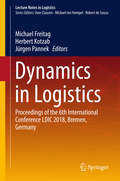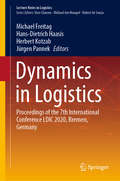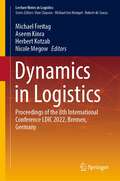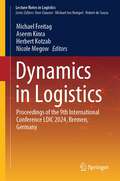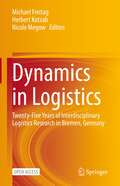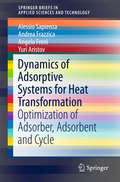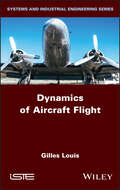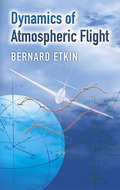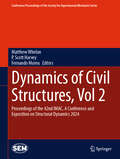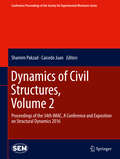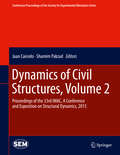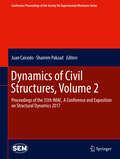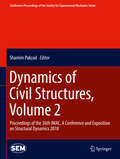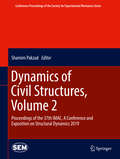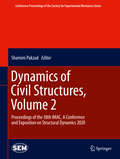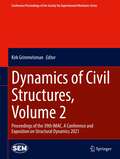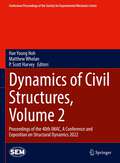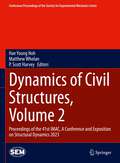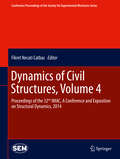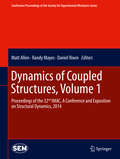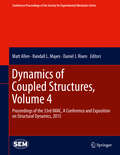- Table View
- List View
Dynamics in Logistics
by Jürgen Pannek Herbert Kotzab Michael FreitagThese proceedings contain research presented at the 6th International Conference on Dynamics in Logistics, held in February 2018.The integration of dynamics within the modeling, planning and control of logistic processes and networks has shown to contribute massively to the improvement of the latter. Moreover, diversification of markets and demand has increased both the complexity and the dynamic changes of problems within the area of logistics. To cope with these challenges, it must become possible to identify, describe and analyze such process changes. Moreover, logistic processes and networks must be revised to be rapidly and flexibly adaptable to continuously changing conditions. This book presents new ideas to solve such problems, offering technological, algorithmic and conceptual improvements. It primarily addresses researchers and practitioners in the field of industrial engineering and logistics.
Dynamics in Logistics: First International Conference, Ldic 2007, Bremen, Germany, August 2007. Proceedings (Lecture Notes In Logistics Series)
by Jürgen Pannek Herbert Kotzab Michael Freitag Hans-Dietrich HaasisSince 2007, the biennial International Conferences on Dynamics in Logistics (LDIC) offers researchers and practitioners from logistics, operations research, production, industrial and electrical engineering as well as from computer science an opportunity to meet and to discuss the latest developments in this particular research domain. From February 12th to 14th 2020 for the seventh time, LDIC 2020 is held in Bremen, Germany. Similar to its six predecessors, the Bremen Research Cluster for Dynamics in Logistics (LogDynamics) organizes this conference. The spectrum of topics reaches from the dynamic modeling, planning and control of processes over supply chain management and maritime logistics to innovative technologies and robotic applications for cyber-physical production and logistics systems. LDIC 2020 provides a forum for the discussion of advances in that matter. The conference program consists of three invited keynote speeches and 51 papers selected by a severe double-blind reviewing process. Within these proceedings all the papers are published. By this, the proceedings give an interdisciplinary outline on the state of the art of dynamics in logistics as well as identify challenges and solutions for logistics today and tomorrow.
Dynamics in Logistics: Proceedings of the 7th International Conference LDIC 2020, Bremen, Germany (Lecture Notes in Logistics)
by Jürgen Pannek Herbert Kotzab Michael Freitag Hans-Dietrich HaasisSince 2007, the biennial International Conferences on Dynamics in Logistics (LDIC) offers researchers and practitioners from logistics, operations research, production, industrial and electrical engineering as well as from computer science an opportunity to meet and to discuss the latest developments in this particular research domain. From February 12th to 14th 2020 for the seventh time, LDIC 2020 is held in Bremen, Germany. Similar to its six predecessors, the Bremen Research Cluster for Dynamics in Logistics (LogDynamics) organizes this conference. The spectrum of topics reaches from the dynamic modeling, planning and control of processes over supply chain management and maritime logistics to innovative technologies and robotic applications for cyber-physical production and logistics systems. LDIC 2020 provides a forum for the discussion of advances in that matter. The conference program consists of three invited keynote speeches and 51 papers selected by a severe double-blind reviewing process. Within these proceedings all the papers are published. By this, the proceedings give an interdisciplinary outline on the state of the art of dynamics in logistics as well as identify challenges and solutions for logistics today and tomorrow.
Dynamics in Logistics: Proceedings of the 8th International Conference LDIC 2022, Bremen, Germany (Lecture Notes in Logistics)
by Herbert Kotzab Michael Freitag Nicole Megow Aseem KinraSince 2007, the biennial International Conferences on Dynamics in Logistics (LDIC) offers researchersand practitioners from logistics, operations research, production, industrial and electrical engineering aswell as from computer science an opportunity to meet and to discuss the latest developments in thisparticular research domain. From February 23th to 25th 2022 for the eighth time, LDIC 2022 was held inBremen, Germany. Similar to its seven predecessors, the Bremen Research Cluster for Dynamics inLogistics (LogDynamics) organized this conference. The spectrum of topics reaches from the dynamicmodeling, planning and control of processes over supply chain management and maritime logistics toinnovative technologies and robotic applications for cyber-physical production and logistics systems.LDIC 2022 provided a forum for the discussion of advances in that matter. The conference programconsisted of keynote speeches and research papers selected by a severe double-blind reviewing process.Within these proceedings all the papers are published. By this, the proceedings give an interdisciplinaryoutline on the state of the art of dynamics in logistics as well as identify challenges and solutions forlogistics today and tomorrow.
Dynamics in Logistics: Proceedings of the 9th International Conference LDIC 2024, Bremen, Germany (Lecture Notes in Logistics)
by Herbert Kotzab Michael Freitag Nicole Megow Aseem KinraThis book reports on interdisciplinary research and developments in logistics. It describes cutting-edge methods from business economics, operations research, computer science, and electrical and production engineering, applied to solve current problems in logistics. It includes empirical, theoretical, methodological, and practice-oriented contributions addressing the modeling, planning, optimization, and control of processes in supply chains, logistic networks, production systems, and material flow systems and facilities. Gathering peer-reviewed papers presented at the 9th International Conference on Dynamics in Logistics (LDIC 2024), held on February 14-16, 2024, in Bremen, Germany, and continuing the tradition of previous volumes, this book offers extensive information to both researchers and professionals in logistics. Moreover, it emphasizes current challenges such as those related to sustainable business development and digitalization, proposing novel, effective solutions to cope with current issues in different types of industry.
Dynamics in Logistics: Twenty-Five Years of Interdisciplinary Logistics Research in Bremen, Germany
by Herbert Kotzab Michael Freitag Nicole MegowThis open access book highlights the interdisciplinary aspects of logistics research. Featuring empirical, methodological, and practice-oriented articles, it addresses the modelling, planning, optimization and control of processes. Chiefly focusing on supply chains, logistics networks, production systems, and systems and facilities for material flows, the respective contributions combine research on classical supply chain management, digitalized business processes, production engineering, electrical engineering, computer science and mathematical optimization. To celebrate 25 years of interdisciplinary and collaborative research conducted at the Bremen Research Cluster for Dynamics in Logistics (LogDynamics), in this book hand-picked experts currently or formerly affiliated with the Cluster provide retrospectives, present cutting-edge research, and outline future research directions.
Dynamics in Microwave Chemistry
by Kama Huang Xiaoqing Yang Huacheng ZhuThis book addresses microwave chemistry at both the physical and molecular level. Its main goal is to elaborate the highly complex scientific issues involved in the fundamental theory of microwave chemistry, and in industrialized applications in the near future.The book provides detailed insights into the characterization and measurement of dielectric properties under complex conditions, such as chemical reactions, high-temperature environments, etc. Considerable attention is paid to the theory of dynamics in microwave chemistry, from the view of both physical level and molecular level. Microwave-Material Interactions simulation is used for physical dynamical analysis, while a Microwave-Molecules Interactions methodology is proposed for molecular dynamical analysis. In turn, calculational examples are introduced for better description and validation, respectively. Lastly, the book proposes design strategies and calculational examples for large-scale application.Richly illustrated and including a wealth of worked-out examples, this book is ideal for all researchers, students and engineers who are just getting started in the dynamics of microwave chemistry.
Dynamics of Adsorptive Systems for Heat Transformation: Optimization Of Adsorber, Adsorbent And Cycle (SpringerBriefs in Applied Sciences and Technology)
by Angelo Freni Andrea Frazzica Alessio Sapienza Yuri AristovThis book investigates the adsorption dynamics of water, methanol, ethanol, and ammonia vapor on loose and consolidated adsorbent beds, as well as the impact of this aspect on the overall performance of adsorption systems for heat transformation. In particular, it presents the results of kinetic measurements made using the large temperature jump (LTJ) method, the most efficient way to study adsorption dynamics under realistic operating conditions for adsorptive heat transformers. The information provided is especially beneficial for all those working on the development of novel adsorbent materials and advanced adsorbers for heating and cooling applications. Today, technologies and systems based on adsorption heat transformation (AHT) processes offer a fascinating option for meeting the growing worldwide demand for air conditioning and space heating. Nevertheless, considerable efforts must still be made in order to enhance performance so as to effectively compete with commonly used electrical compression and absorption machines. For this purpose, intelligent design for adsorption units should above all focus on finding a convenient choice of adsorbent material by means of a comprehensive analysis that takes into account both thermodynamic and dynamic aspects. While the thermodynamic properties of the AHT cycle have been studied extensively, the dynamic optimization of AHT adsorbers is still an open issue. Several efforts have recently been made in order to analyze AHT dynamics, which greatly influence overall AHT performance.
Dynamics of Aircraft Flight
by Gilles LouisPerformance calculations can be classified into three main types: lift, thrust and slope. Firstly, since the lift profile is known and unmodifiable from the time an aircraft is designed, the mass at a given speed or the speed at a given mass must be determined. Then, once the thrust of the engines and the mass are known, the slope must be calculated. Finally, once the slope is known (for example, level flight) as well as the mass, it is necessary to deduce the thrust; this is the position of the throttle control lever that ensures balance. The corresponding consumption must then be defined. Performance specifications for customer aircraft, such as manoeuvrability, fuel consumption, maintenance, safety and testability, have become ever more demanding with each generation of equipment. Major technical advances have been required: wing profiles, engines, materials to reduce mass, etc. This book presents a theoretical approach to flight mechanics that makes it possible to grasp the subject and links it with the empirical approach of manufacturers.
Dynamics of Atmospheric Flight (Dover Books on Aeronautical Engineering)
by Bernard EtkinGeared toward upper-level undergrads, graduate students, and practicing engineers, this comprehensive treatment of the dynamics of atmospheric flight focuses especially on the stability and control of airplanes. An extensive set of numerical examples covers STOL airplanes, subsonic jet transports, hypersonic flight, stability augmentation, and wind and density gradients.The equations of motion receive a very full treatment, including the effects of the curvature and rotation of the Earth and distortional motion. Complete chapters are given to human pilots and handling qualities and to flight in turbulence, with numerical examples for a jet transport. Small-perturbation equations for longitudinal and lateral motion appear in convenient matrix forms, both in time-domain and Laplace transforms, dimensional and nondimensional.
Dynamics of Civil Structures, Vol. 2: Proceedings of the 42nd IMAC, A Conference and Exposition on Structural Dynamics 2024 (Conference Proceedings of the Society for Experimental Mechanics Series)
by Matthew Whelan P. Scott Harvey Fernando MoreuDynamics of Civil Structures, Volume 2: Proceedings of the 42nd IMAC, A Conference and Exposition on Structural Dynamics, 2024, the second volume of ten from the Conference brings together contributions to this important area of research and engineering. The collection presents early findings and case studies on fundamental and applied aspects of the Dynamics of Civil Structures, including papers on: Structural Vibration Dynamics of Bridges, Buildings, and Infrastructure Systems Innovative Sensors and Measurement Techniques for Structural Applications Structural Control and Vibration Mitigation Human Induced Vibrations and Human-Structure Interaction Modal Identification of Structural Systems Human Health Monitoring Using Structural Sensing Field Monitoring of Vibrations
Dynamics of Civil Structures, Volume 2
by Shamim Pakzad Caicedo JuanDynamics of Civil Structures, Volume 2. Proceedings of the 34th IMAC, A Conference and Exposition on Dynamics of Multiphysical Systems: From Active Materials to Vibroacoustics, 2016, the second volume of ten from the Conference brings together contributions to this important area of research and engineering. Th e collection presents early fi ndings and case studies on fundamental and applied aspects of Structural Dynamics, including papers on: * Modal Parameter Identifi cation * Dynamic Testing of Civil Structures * Human Induced Vibrations of Civil Structures * Model Updating * Operational Modal Analysis * Damage Detection * Bridge Dynamics * Experimental Techniques for Civil Structures * Hybrid testing * Vibration Control of Civil Structures
Dynamics of Civil Structures, Volume 2
by Shamim Pakzad Juan CaicedoDynamics of Civil Structures, Volume 2. Proceedings of the 33rd IMAC, , A Conference and Exposition on Balancing Simulation and Testing, 2015, the second volume of ten from the Conference brings together contributions to this important area of research and engineering. The collection presents early findings and case studies on fundamental and applied aspects of Structural Dynamics, including papers on: Modal Parameter Identification Dynamic Testing of Civil Structures Human Induced Vibrations of Civil Structures Correlation & Updating Operational Modal Analysis Damage Detection of Structures Bridge Structures Damage Detection Models Experimental Techniques for Civil Structures
Dynamics of Civil Structures, Volume 2
by Shamim Pakzad Juan CaicedoDynamics of Civil Structures, Volume 2. Proceedings of the 34th IMAC, A Conference and Exposition on Dynamics of Multiphysical Systems: From Active Materials to Vibroacoustics, 2016, the second volume of ten from the Conference brings together contributions to this important area of research and engineering. Th e collection presents early fi ndings and case studies on fundamental and applied aspects of Structural Dynamics, including papers on: * Modal Parameter Identifi cation * Dynamic Testing of Civil Structures * Human Induced Vibrations of Civil Structures * Model Updating * Operational Modal Analysis * Damage Detection * Bridge Dynamics * Experimental Techniques for Civil Structures * Hybrid testing * Vibration Control of Civil Structures
Dynamics of Civil Structures, Volume 2: Proceedings of the 36th IMAC, A Conference and Exposition on Structural Dynamics 2018 (Conference Proceedings of the Society for Experimental Mechanics Series)
by Shamim PakzadDynamics of Civil Structures, Volume 2: Proceedings of the 36th IMAC, A Conference and Exposition on Structural Dynamics, 2018, the second volume of nine from the Conference brings together contributions to this important area of research and engineering. The collection presents early findings and case studies on fundamental and applied aspects of the Dynamics of Civil Structures, including papers on: Modal Parameter IdentificationDynamic Testing of Civil StructuresControl of Human Induced Vibrations of Civil StructuresModel UpdatingDamage Identification in Civil InfrastructureBridge DynamicsExperimental Techniques for Civil StructuresHybrid Simulation of Civil StructuresVibration Control of Civil StructuresSystem Identification of Civil Structures
Dynamics of Civil Structures, Volume 2: Proceedings of the 37th IMAC, A Conference and Exposition on Structural Dynamics 2019 (Conference Proceedings of the Society for Experimental Mechanics Series)
by Shamim PakzadDynamics of Civil Structures, Volume 2: Proceedings of the 37th IMAC, A Conference and Exposition on Structural Dynamics, 2019, the second volume of eight from the Conference brings together contributions to this important area of research and engineering. The collection presents early findings and case studies on fundamental and applied aspects of the Dynamics of Civil Structures, including papers on:Structural Vibration Humans & Structures Innovative Measurement for Structural Applications Smart Structures and Automation Modal Identification of Structural Systems Bridges and Novel Vibration Analysis Sensors and Control
Dynamics of Civil Structures, Volume 2: Proceedings of the 38th IMAC, A Conference and Exposition on Structural Dynamics 2020 (Conference Proceedings of the Society for Experimental Mechanics Series)
by Shamim PakzadDynamics of Civil Structures, Volume 2: Proceedings of the 38th IMAC, A Conference and Exposition on Structural Dynamics, 2020, the second volume of eight from the Conference brings together contributions to this important area of research and engineering. The collection presents early findings and case studies on fundamental and applied aspects of the Dynamics of Civil Structures, including papers on:Structural VibrationHumans & Structures Innovative Measurement for Structural Applications Smart Structures and Automation Modal Identification of Structural Systems Bridges and Novel Vibration Analysis Sensors and Control
Dynamics of Civil Structures, Volume 2: Proceedings of the 39th IMAC, A Conference and Exposition on Structural Dynamics 2021 (Conference Proceedings of the Society for Experimental Mechanics Series)
by Kirk GrimmelsmanDynamics of Civil Structures, Volume 2: Proceedings of the 39th IMAC, A Conference and Exposition on Structural Dynamics, 2021, the second volume of nine from the Conference brings together contributions to this important area of research and engineering. The collection presents early findings and case studies on fundamental and applied aspects of the Dynamics of Civil Structures, including papers on:Structural VibrationHumans & StructuresInnovative Measurement for Structural ApplicationsSmart Structures and Automation Modal Identification of Structural SystemsBridges and Novel Vibration AnalysisSensors and Control
Dynamics of Civil Structures, Volume 2: Proceedings of the 40th IMAC, A Conference and Exposition on Structural Dynamics 2022 (Conference Proceedings of the Society for Experimental Mechanics Series)
by Hae Young Noh Matthew Whelan P. Scott HarveyDynamics of Civil Structures, Volume 2: Proceedings of the 40th IMAC, A Conference and Exposition on Structural Dynamics, 2022, the second volume of nine from the Conference brings together contributions to this important area of research and engineering. The collection presents early findings and case studies on fundamental and applied aspects of the Dynamics of Civil Structures, including papers on:Structural VibrationHumans & StructuresInnovative Measurement for Structural ApplicationsSmart Structures and Automation Modal Identification of Structural SystemsBridges and Novel Vibration AnalysisSensors and Control
Dynamics of Civil Structures, Volume 2: Proceedings of the 41st IMAC, A Conference and Exposition on Structural Dynamics 2023 (Conference Proceedings of the Society for Experimental Mechanics Series)
by Hae Young Noh Matthew Whelan P. Scott HarveyDynamics of Civil Structures, Volume 2: Proceedings of the 41st IMAC, A Conference and Exposition on Structural Dynamics, 2023, the second volume of ten from the Conference brings together contributions to this important area of research and engineering. The collection presents early findings and case studies on fundamental and applied aspects of the Dynamics of Civil Structures, including papers on:Structural VibrationsStructural Health MonitoringHuman-Structure InteractionVibration Control and MitigationInnovative Sensing for Structural ApplicationsSmart Structures and AutomationModal Identification of Structural SystemsDynamics of Buildings, Bridges, and Off-Shore Platforms
Dynamics of Civil Structures, Volume 4
by Fikret Necati CatbasThis fourth volume of eight from the IMAC - XXXII Conference, brings together contributions to this important area of research and engineering. The collection presents early findings and case studies on fundamental and applied aspects of Structural Dynamics, including papers on: Linear Systems Substructure Modelling Adaptive Structures Experimental Techniques Analytical Methods Damage Detection Damping of Materials & Members Modal Parameter Identification Modal Testing Methods System Identification Active Control Modal Parameter Estimation Processing Modal Data
Dynamics of Composite Materials (Advances in Dielectrics)
by Andreas Schönhals Paulina SzymoniakThe book presents recent developments in the field of composites, investigated by Broadband Dielectric Spectroscopy (BDS) and sheds a special focus on nanocomposites. This volume compares the results obtained by BDS with data from other methods like hyphenated calorimetry, dynamical-mechanical spectroscopy, NMR spectroscopy and neutron scattering. The addressed systems range from all kinds of model systems, such as polymers filled with spherical silica particles, advanced materials such as polymers with molecular stickers or hyperbranched polymer-based matrices to industrially significant systems, like epoxy-based materials. The book offers an excellent insight to a valuable application of dielectric spectroscopy and it is a helpful guide for every scientist who wants to study dynamics in composite materials.
Dynamics of Compressible Fluids: A Textbook
by Oleksandr GirinCompressibility is a property inherent in any material, but it does not always manifest itself. Experience suggests that it affects the medium motion only at velocities comparable to the speed of sound. Why do we study compressibility? It turns out that in order to calculate the aircraft streamlining or the internal flow in its engine, or the shell muzzle velocity, or the dynamic load of a shock wave from an accidental blast on a structural element, and in many other cases it is necessary to know and understand the laws of the Dynamics of Compressible Media (DCM) and be able to apply them in practice. This textbook is designed to help readers achieve this goal and learn the basics of DCM. This field of knowledge is high-tech and always focuses on the future: modern developments of hypersonic aircraft, designing more advanced structural elements for airplanes and helicopters, calculating the car aerodynamics, etc. Paradoxes have always given impetus to the search for new technological devices. Unusual effects in DCM include the flow chocking in supersonic outflow from reservoirs (Sect.2.2); the shock wave formation inside an initially smooth flow (Sect.5.3); the generation of a "spallation saucer" of armor inside a tank when a shell hits it (Sect.5.5); the dog-leg of a plane discontinuity surface at shockwave reflection from a rigid wall (Sec.8.1). The way to understand these and other effects is through the creation of quantitative models of a moving compressible fluid.
Dynamics of Coupled Structures, Volume 1
by Matt Allen Daniel Rixen Randy MayesThis first volume of eight from the IMAC-XXXII Conference, brings together contributions to this important area of research and engineering. The collection presents early findings and case studies on fundamental and applied aspects of Structural Dynamics, including papers on: Linear Systems Substructure Modelling Adaptive Structures Experimental Techniques Analytical Methods Damage Detection Damping of Materials & Members Modal Parameter Identification Modal Testing Methods System Identification Active Control Modal Parameter Estimation Processing Modal Data
Dynamics of Coupled Structures, Volume 4
by Daniel J. Rixen Matt Allen Randall L. MayesDynamics of Coupled Structures, Volume 4. Proceedings of the 33rd IMAC, A Conference and Exposition on Balancing Simulation and Testing, 2015, the fourth volume of ten from the Conference brings together contributions to this important area of research and engineering. The collection presents early findings and case studies on fundamental and applied aspects of Structural Dynamics, including papers on: Substructuring and the Ampair Wind Turbine Test Bed Experimental Dynamic Substructuring Reduced Order Models Experimental Studies of Joints and Joined Structures Analytical/Numerical Modeling of Joints Industrial Applications of Substructuring
